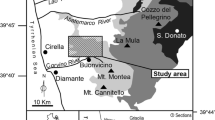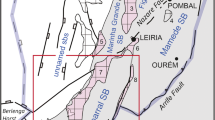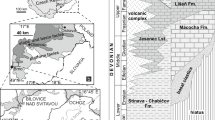Summary
The palaeoecology of calcimicrobial communities from the only Gondwana-related Lower Cambrian in Central Europe (eastern Germany, carbonates and siliciclastics) has been studied. Six morphological groups of calcimicrobes are described. Some of them show a significant ability for sediment stabilization and construction of biohermal reef mounds. Other types of calcimicrobes were more common in biostromal thickets. Some of them were capable of populating different environments, growing in different modes and on different substrates. AnEpiphyton-archaeocyathan reef mound is described, illustrating the importance of calcimicrobes for mound formation. The fossil communities together with a complex of sedimentary features allow a reconstruction of the depositional history of the environment. Based on comparison with similar Gondwanan Lower Cambrian successions (Sardinia/Italy, Spain) and facies development a model is proposed describing the sedimentary history. Three depositional stages are distinguished: (1) deep subtidal ramp, (2) shallow subtidal ramp, (3) shallow subtidal to intertidal mixed siliciclastic-carbonate ramp with migrating oolitic shoals. In spite of similarities with the deposits in southern Europe, some distinct differences exist with respect to the succession of facies, the completeness of the sections, the fossil spectrum, and the nature of the siliciclastic sediments. For the German Lower Cambrian, a facies development from a low energy deep environment to a high energy shallow environment (partly restricted and with some evaporites) can be reconstructed. As compared with Sardinia and Spain, the depositional environment of the eastern German Lower Cambrian successions was predominantly characterized by low-energy conditions.
Similar content being viewed by others
References
Aitken, J.D. (1988): Cambrian reefs and mounds.—In:Geldsetzer, H.H.J., James, N.P. & Tebbutt, G.E. (eds.).—Reefs, Canada and adjacent area. Canadian Society of Petroleum Geologists Memoir13, 135–138, Calgary
Alvaro, J.J. &Vennin, E. (1997): Episodic development of Cambrian eocrinoid-sponge meadows in the Iberian Chains (NE Spain).—Facies37, 49–64, Erlangen
Bechstädt, T., Boni, M. & Fröhler, M. (1994): Facies development in early and middle Cambrian time.—In:T. Bechstädt & M. Boni (eds.): Sedimentological, stratigraphical and ore deposits field guide of the autochthonous Cambro-Ordovician of southwestern Sardinia.—Memoir Descritiva Carta Geologia d’Italia,48, 434 p., Roma
Burchette, T.P. & Wright, V.P. (1992): Carbonate ramp depositional systems.—In:Sellwood, B.W. (ed.): Ramps and reefs.—Sedimentary Geology79, 3–57, Amsterdam
Buschmann, B., Linnemann, U., Schneider, J. &Süss, T. (1995): Die cadomische Entwicklung im Untergrund der Torgau-Doberluger Synklinale.—Zeitschrift für geologische Wissenschaften23/5–6, 729–749, Berlin.
Cherchi, A. &Schroeder, R. (1984): Intergrowth of the early Cambrian algaeEpiphyton Bornemann andRenalcis Vologdin from SW Sardinia.—Bolletino della Società Paleontologica Italiana23/2, 141–147, Roma.
Copper, P. (1974): Structure and development of Early Paleozoic reefs.—Proceedings of the Second International Coral Reef Symposium1, 365–386, Brisbane.
Debrenne, F. &Zhuravlev, A.Yu. (1997): Cambrian food web: a brief review.—Geobios,20, 181–188, Villeneuve
Elicki, O. (1992): Faziesanalyse der unterkambrischen Karbonate Deutschlands.—Unpubl. Ph.D. Thesis, TU Bergakademie Freiberg
— (1994): Lower Cambrian carbonates from eastern Germany: palaeontology, stratigraphy and palaeogeography.—Neues Jahrbuch für Geologie und Paläontologie, Abhandlungen191/1, 69–93, Stuttgart.
— (1996): Die Gastropoden und Monoplacophoren der unterkambrischen Görlitz Fauna.—Paläontologie, Stratigraphie, Fazies—Heft 3. Freiberger Forschungshefte,C464, 145–173, Freiberg.
— (1997): Biostratigraphic data of the German Cambrian—recent state of knowledge.—Paläontologie, Stratigraphie, Fazies—Heft 4. Freiberger Forschungshefte,C466, 155–165, Freiberg.
Elicki, O. (1998): First report ofHalkieria and enigmatic globular fossils from the Central European Marianian (Lower Cambrian, Görlitz Syncline, Germany).—Revista Espanola de Paleontologia, No. extr. Homenaje al Prof. Gonzalo Vidal, pp. 51–64, Madrid
Elicki, O. &Schneider, J. (1992): Lower Cambrian (Atdabanian/Botomian) shallow-marine carbonates of the Görlitz Synclinorium (Saxony/Germany).—Facies26, 55–66, Erlangen
Elicki, O. &Debrenne, F. (1993): The Archaeocyatha of Germany. Paläontologie, Stratigraphie, Fazies-Heft 1.—Freiberger Forschungshefte,C450, 3–41, Freiberg
Freyer, G. &Suhr, P. (1987): Über Archaeocyathinen-Funde und den lithologischen Aufbau des Unterkambriums im Gebiet von Torgau.—Zeitschrift für geologische Wissenschaften15/6, 665–680, Berlin
— & — (1992): Über Algengemeinschaften aus der unterkambrischen Zwethauer Folge des Gebietes von Torgau.—Freiberger Forschungshefte,C445, 49–65, Leipzig
Fröhler, M. &Bechstädt, T. (1992): Calcimicrobial-archaeocyathan buildups at the instable northwestern platform margin of the Lower Cambrian Gonnesa Formation, SW-Sardinia (Italy).—Neues Jahrbuch für Geologie und Paläontologie-Monatshefte1992/5, 267–278, Stuttgart
Geyer, G. &Elicki, O. (1995): The Lower Cambrian trilobites from the Görlitz Synclinorium (Germany)—review and new results.—Paläontologische Zeitschrift69/1–2, 85–117, Stuttgart
Göthel, M. &Elicki, O. (1995): Das Görlitzer Unterkambriumeine variszische Duplexstruktur im Görlitzer Synklinorium?.—Natur und Landschaft der Niederlausitz17, 99–116, Cottbus
James, N.P. &Gravestock, D.I. (1990): Lower Cambrian shelf and shelf margin buildups, Flinders Range, South Australia.—Sedimentology37, 455–480, Oxford
Kobluk, D.R. &James, N.P. (1979): Cavity-dwelling organisms in Lower Cambrian patch reefs from southern Labrador.—Lethaia12, 193–218, Oslo
Krasnopeeva, P.S. (1937): Vodorosli i arkheociaty drevnejzhikh tolsh Potehinskovo plansheta Hakassin.—Materialy po geologii Krasnoyarsovo kraya, vyp. 3. (in Russian)
Kruse, P.D., Zhuravlev, A.Yu. &James, N.P. (1995): Primordial metazoan-calcimicrobial reefs: Lower Cambrian, Aldan River, Siberian Platform.—Palaios10, 291–321, Tulsa
Luchinina, V.A. (1975): Paleoalgologicheskaya kharakteristika rannevo kembriya Sibirskoi platformy.—Akad. Nauk SSSR. Novosibirsk. vyp.216. (in Russian)
Read, B.C. (1980): Lower Cambrian archaeocyathid buildups, Pelly Mountains, Yukon.—Geological Survey of Canada 78-18, 54 p., Ottawa
Rees, M.N., Pratt, B.R. &Rowell, A. (1989): Early Cambrian reef complexes and associated lithofacies of the Shackleton limestone, Transantarctic Mountains.—Sedimentology36, 341–361, Oxford
Reineck, H.-E. &Singh, I.B. (1980): Depositional sedimentary environments.—439 p., Berlin (Springer)
Riding, R. (1988): Classification of microbial carbonates. Benthic microbes and reefs.—6th International Coral Reef Symposium, Townsville, abstracts, 5p.
— (1991): Classification of microbial carbonates.—In:Riding, R. (ed.): Calcareous algae and stromatolites.—21–51, New York (Springer)
— (1992): Temporal variation in calcification in marine cyanobacteria.—Journal of the Geological Society149, 979–989, London
Riding, R. &Voronova, L. (1985): Morphological groups and series in Cambrian calcareous algae.—In:Toomey, D.F. &Nitecki, M.H. (Eds.): Paleoalgology: contemporary research and applications.—56–78, Berlin (Springer)
Rowland, S.M. (1984): Were there framework reefs in the Cambrian?.—Geology12, 181–183, Boulder
Rowland, S.M. &Gangloff, R.A. (1988): Structure and paleoecology of Lower Cambrian reefs.—Palaios3, 111–135, Tulsa
Schwarzbach, M. (1934): Das Cambrium der Oberlausitz.—Abhandlungen der Naturforschenden Gesellschaft Görlitz32/2, 7–5, Görlitz
Sdzuy, K. (1972): Das Kambrium der acadobaltischen Faunenprovinz.—Zentralblatt für Geologie und Paläontologie2/1, 1–91, Stuttgart
wood, R. (1995): The changing biology of reef-building.—Palaios10, 517–529, Tulsa
Wood, R., Zhuravlev, A.Yu. &Chimed Tseren, A. (1993): The ecology of Lower Cambrian buildups from Zuune Arts, Mongolia: implications for early metazoan reef evolution.—Sedimentology40, 829–858, Oxford
Zhuravlev, A.Yu. (1996): Reef ecosystem recovery after the Early Cambrian extinction.—In:Hart, M.B.D. (ed.): Biotic recovery from mass extinction events.—Geological Society of London Special Publications102, 79–96, London
Zhuravlev, A.Yu. &Debrenne, F. (1996): Pattern of evolution of Cambrian benthic communities: environments of carbonate sedimentation.—Rivista Italiana di Paleontologia e Stratigrafia102/3, 333–340, Milano
Zhuravlev, A.Yu. &Wood, R. (1995): Lower Cambrian reefal cryptic communities.—Palaeontology38/2, 443–470, London
Author information
Authors and Affiliations
Rights and permissions
About this article
Cite this article
Elicki, O. Palaeoecological significance of calcimicrobial communities during ramp evolution: An example from the Lower Cambrian of Germany. Facies 41, 27–39 (1999). https://doi.org/10.1007/BF02537458
Accepted:
Published:
Issue Date:
DOI: https://doi.org/10.1007/BF02537458




